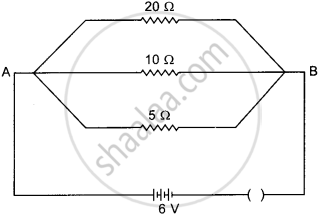Advertisements
Advertisements
Question
In parallel combination of resistances ______.
Options
p.d. is same across each resistance
total resistance is increased
current is same in each resistance
all of the above are true
Solution
In parallel combination of resistances p.d. is same across each resistance.
Explanation:
In parallel combination, the ends of each resistor are connected to the ends of the same source of potential. Thus, the potential difference across each resistance is same and is equal to the potential difference across the terminals of the source (or battery).
APPEARS IN
RELATED QUESTIONS
Show how would you join three resistors, each of resistance 9 Ω so that the equivalent resistance of the combination is
1) 13.5
2) 6 Ω
Which of the following arrangement, A or B, has the lower combined resistance?

Two resistances when connected in parallel give resultant value of 2 ohm; when connected in series the value becomes 9 ohm. Calculate the value of each resistance.
You are given three resistances of 1, 2 and 3 ohms. Shows by diagrams, how with the help of these resistances you can get:
(i) 6 Ω
(ii) `6/1` Ω
(iii) 1.5 Ω
If current flows through two lamps arranged:
(a) in series,
(b) in parallel,
and the filament of one lamps breaks, what happens to the other lamp? Explain your answer.
Which of the following combinations have the same equivalent resistance between X and Y?
Five resistors, each 3 Ω, are connected as shown in Fig. Calculate the resistance
- between the points P and Q.
- between the points X and Y.

What are the advantages of a parallel connection?
A particular resistance wire has a resistance of 3 ohm per meter. Find :
The total resistance of three lengths of this wire each 1.5 m long, in parallel.
Calculate the current flows through the 10 Ω resistor in the following circuit.

